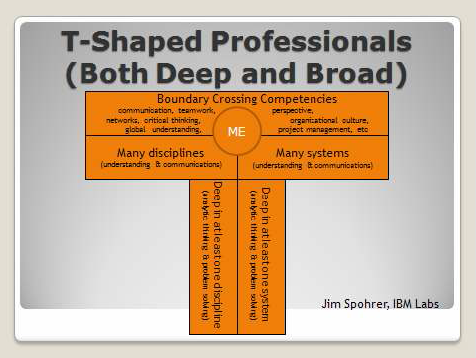T-Shaped Professional
The emerging skills gap (see publications) means a shift in the type of young professional that will be needed to successfully lead organizations in the new economy. I have tried to explain this shift, using normal distribution curves with the “I individual” removed and the severed funnel. Both images may work in a presentation but fail to grab one’s long term attention. I was introduced to the concept of the “T Professional” through the writing of Judy Estrin who attributes this concept to colleagues at IDEO Design. In one of those serendipitous moments, Jim Spohrer at IBM Labs and I connected where I learned more about T professional development and how it closely aligned to my thoughts about college students.
The following figure illustrates the T Professional as envisioned by Jim and his colleagues with a little adaptation by me. The components of the system include: mastery of a discipline, mastery of a system, transdisciplinary knowledge used in the system, mastery of additional systems (as T grows), boundary crossing skills, and ME (knowing who I am and where I want to go). Jim and I are working on a guide for college students on how to build your Model T. Until that is ready we are assembling all the material we can find on T Professionals so that you can become more familiar with the term and its implications. While the engineers are out in front on this concept – every field will require T professional development.
Here's a recent whitepaper I wrote with Doug Estry, PhD: A Primer on the T-professional
These items are information provided by Jim Spohrer about the necessity of T-Shaped Professionals:
Collaborative Innovation and Services Systems: Implications for Institutions and Disciplines (2008)
K-12 Engineering - the Missing Core Discipline (tbd)
Research-Driven Medical Education and Practice: A Case for T-Shaped Professionals (tbd)
Transformational Engineering Education (tbd)
These are various articles below on the effectiveness on the uprising of T-Shaped professionals. Articles also include those focusing on the skills that the professional must have and the usage of T-Shaped managers.
A Primer on the T-professional (2017)
Capabilities, Processes, and Performance of Knowledge Management: A Structural Approach (2007)
Succeeding Through Service Innovation (2007)
T-Shaped Professionals, T-Shaped Skills, Hybrid Managers (2008)


